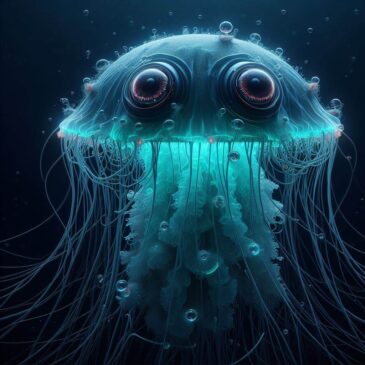What do you need to know about jellyfish?
Absolutely! Here’s a comprehensive guide to jellyfish, covering their biology, ecology, and fascinating characteristics.
Introduction to Jellyfish
Jellyfish are mysterious and intriguing creatures that inhabit all of the world’s oceans, from the surface waters to the deepest depths. They belong to the phylum Cnidaria, which also includes corals and sea anemones. Despite their name, jellyfish are not actually fish; they are gelatinous invertebrates.
Anatomy and Biology
Jellyfish have a simple body structure consisting of a gelatinous umbrella-shaped bell and trailing tentacles. The bell serves as the jellyfish’s propulsion system, allowing it to move through the water by contracting and relaxing its muscles. The tentacles contain specialized cells called cnidocytes, which are equipped with stinging structures called nematocysts. These nematocysts are used for both hunting prey and defending against predators.
Jellyfish have a decentralized nervous system, with nerve cells distributed throughout their body. They lack a brain or centralized control center but are still capable of responding to their environment through instinctual behaviors.
Diversity of Jellyfish
There are thousands of species of jellyfish, ranging in size from just a few millimeters to several meters in diameter. They come in a variety of shapes, colors, and forms, each adapted to its own ecological niche.
Some of the most well-known jellyfish species include the moon jellyfish (Aurelia aurita), the lion’s mane jellyfish (Cyanea capillata), and the box jellyfish (Chironex fleckeri), known for its potent venom.
Ecology and Habitat
Jellyfish are found in virtually every marine environment, from coastal waters to the open ocean and even in freshwater lakes and rivers. They are highly adaptable and can thrive in a wide range of conditions, from the tropics to polar regions.
Many jellyfish species are planktonic, drifting with the ocean currents, while others are capable of active swimming. Some species are even able to migrate vertically in the water column, moving closer to the surface at night to feed and descending to deeper waters during the day to avoid predators.
Feeding and Predation
Jellyfish are opportunistic feeders, consuming a variety of prey including small fish, zooplankton, and even other jellyfish. They use their tentacles to capture prey, paralyzing them with their stinging cells before ingesting them whole.
Despite their venomous sting, jellyfish themselves are preyed upon by a variety of predators, including sea turtles, fish, and seabirds. Some species have developed unique adaptations to avoid predation, such as transparent bodies or bioluminescence.
Reproduction and Life Cycle
The life cycle of a jellyfish typically consists of several stages, including a larval stage, a polyp stage, and a medusa (adult) stage. During the medusa stage, jellyfish are typically either male or female, releasing eggs or sperm into the water for fertilization.
After fertilization, the eggs develop into larvae, which eventually settle on the seafloor and transform into polyps. The polyps reproduce asexually, forming buds that develop into new medusae, thus completing the life cycle.
Human Interactions and Impact
While jellyfish play important ecological roles as both predators and prey, they can also have significant impacts on human activities. Large blooms of jellyfish can clog fishing nets, disrupt tourism, and even damage power plant intakes.
Additionally, jellyfish stings can pose a risk to swimmers and beachgoers, causing pain, skin irritation, and in some cases, more severe allergic reactions. However, advances in medical treatment and public awareness campaigns have helped to mitigate these risks in many areas.
Conclusion
Jellyfish are truly fascinating creatures, with a diverse range of adaptations and behaviors that have allowed them to thrive in oceans around the world for millions of years. While they may sometimes be viewed as nuisances or hazards, they are an integral part of marine ecosystems and serve as important indicators of ocean health. Understanding and appreciating these remarkable animals is essential for protecting the delicate balance of life in our oceans.

The Mystical World of Jellyfish: A Deep Dive into Their Enigmatic Existence
In the vast and mysterious depths of the ocean, among the ethereal dance of sea creatures, one entity stands out for its enigmatic beauty and captivating allure – the jellyfish. Often regarded as the pulsating ghosts of the sea, jellyfish are an ancient lineage of marine animals that have intrigued scientists and mesmerized observers for centuries.
Evolutionary Marvels
Jellyfish, belonging to the phylum Cnidaria, have been inhabiting the Earth’s oceans for over 500 million years, making them one of the oldest living organisms on the planet. Despite their ancient origins, jellyfish have evolved into a diverse array of species, ranging from the graceful and translucent moon jellyfish to the fearsome and venomous box jellyfish.
Intriguing Anatomy
At first glance, jellyfish may appear as delicate and simple creatures, but their anatomy harbors a fascinating complexity. Their bell-shaped bodies, often translucent or luminescent, are adorned with trailing tentacles armed with stinging cells called nematocysts. These stingers, which contain toxins used for prey capture and defense, are among the most sophisticated weapons in the animal kingdom.
Mysteries of Movement
Jellyfish move through the water with a grace and fluidity that seem almost otherworldly. Unlike most marine animals, jellyfish lack bones, muscles, and a centralized nervous system. Instead, they rely on a simple network of nerves and muscles, coupled with the pulsations of their bell-shaped bodies, to propel themselves forward. This unique mode of locomotion allows jellyfish to navigate the ocean currents with remarkable efficiency.
Ecological Significance
Despite their reputation as oceanic drifters, jellyfish play a crucial role in marine ecosystems. As opportunistic predators, they help regulate the populations of planktonic organisms, thus maintaining the delicate balance of the marine food web. Additionally, jellyfish serve as prey for a variety of marine animals, including sea turtles, sunfish, and certain species of fish, contributing to the biodiversity of the oceanic realm.
Environmental Challenges
While jellyfish have thrived for millions of years, they are not immune to the environmental challenges facing our oceans today. Factors such as climate change, overfishing, and pollution have led to an increase in jellyfish populations in many parts of the world. This phenomenon, known as jellyfish blooms, can have significant ecological and economic impacts, including the depletion of fish stocks, disruption of fisheries, and damage to tourism and aquaculture industries.
Scientific Curiosity
Despite their ubiquity in the oceans, jellyfish remain a subject of scientific curiosity and exploration. Researchers are continually studying their biology, behavior, and ecological roles to gain a deeper understanding of these mysterious creatures. Recent advancements in technology, such as underwater robotics and genetic analysis, have allowed scientists to unravel the secrets of jellyfish in ways previously thought impossible.
Cultural Significance
Jellyfish have also captured the imagination of cultures around the world, inspiring art, literature, and mythology. In Japanese folklore, the jellyfish is revered as a symbol of resilience and adaptability, while in Western literature, it often symbolizes mystery and the unknown depths of the sea. Today, jellyfish continue to fascinate and inspire artists, writers, and filmmakers, serving as both muse and metaphor in creative expression.
Conservation Efforts
As awareness of the importance of marine conservation grows, efforts to protect jellyfish and their habitats are gaining momentum. Conservation initiatives focus on reducing pollution, mitigating climate change, and implementing sustainable fishing practices to safeguard the delicate balance of the marine ecosystem. By preserving the oceanic environment, we can ensure the continued existence of these captivating and enigmatic creatures for generations to come.
In conclusion, jellyfish are not merely drifting specters of the sea; they are complex and fascinating organisms that have adapted to thrive in the ever-changing environment of the ocean. From their evolutionary origins to their ecological significance, jellyfish embody the mysteries and wonders of the natural world, inviting us to explore and appreciate the beauty and diversity of marine life.

